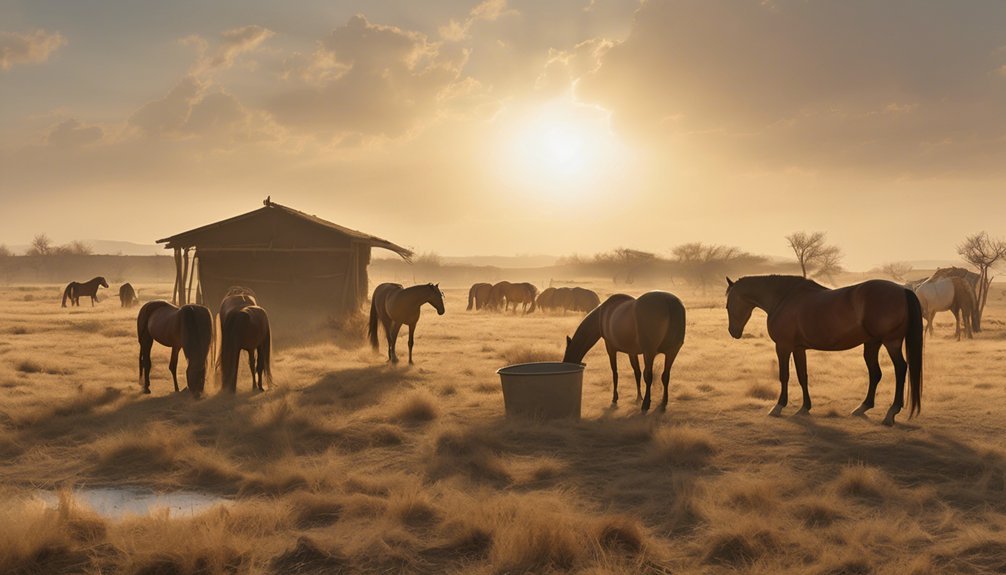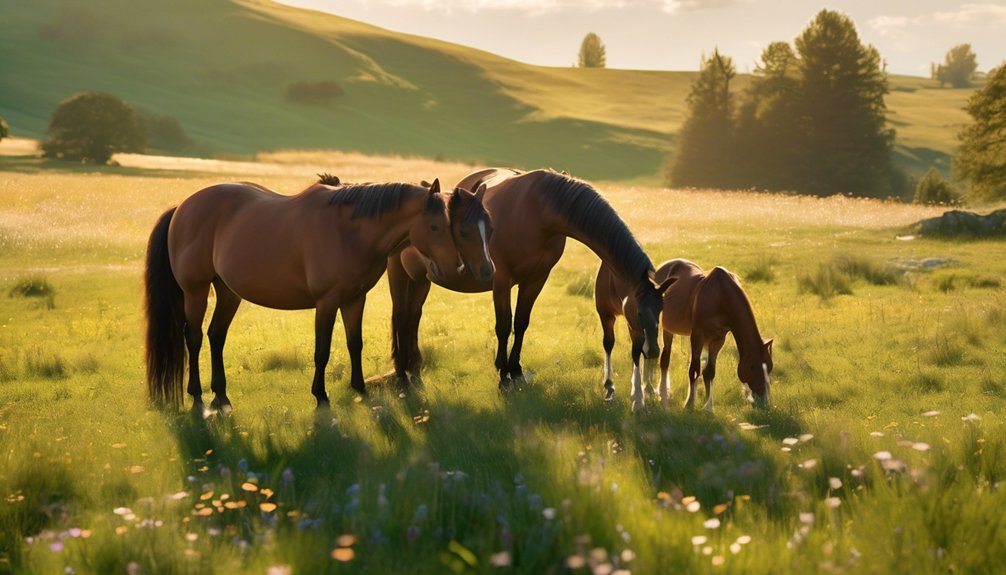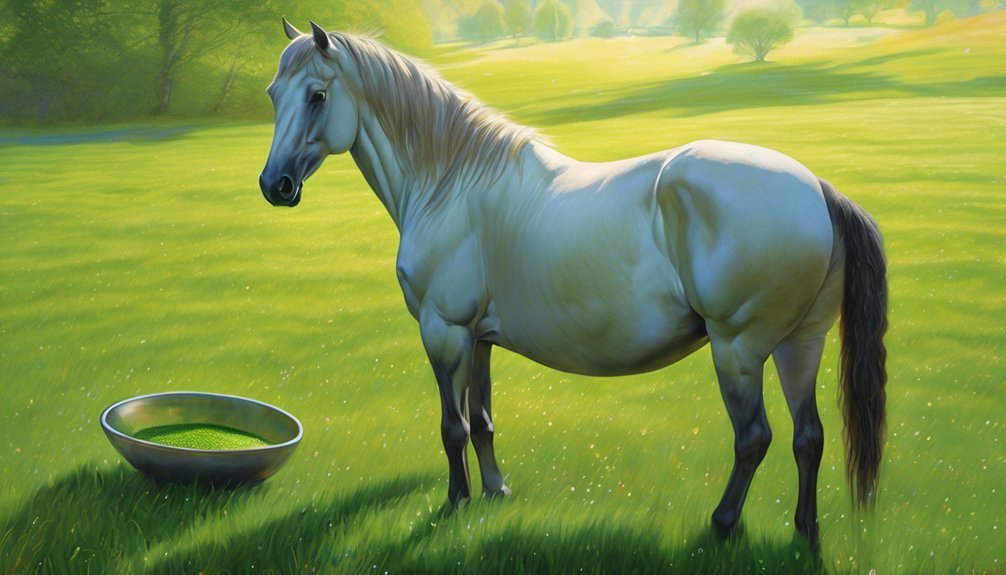
Is it true that horses can thrive even in the harshest dry or drought conditions? While many believe that adequate forage is essential for equine health, the reality is more complex. You need to assess your horse's nutritional needs and forage quality carefully. Understanding alternative feeding strategies can make a significant difference. How you manage their diet during these challenging times could determine your horse's well-being and performance.
Key Takeaways
- Conduct regular forage testing to assess nutritional value and adjust diets accordingly based on the results.
- Supplement with essential vitamins and minerals to prevent deficiencies due to limited forage availability.
- Use high-quality hay free from mold and dust to support overall horse nutrition during drought conditions.
- Explore alternative grains and protein sources to maintain energy levels and meet nutritional requirements.
- Ensure access to fresh water and monitor intake, using electrolytes to encourage hydration as needed.
Understanding Nutritional Needs of Horses in Dry Conditions

How do drought conditions impact your horse's nutritional needs? In times of dry weather, your horse may face increased risks of nutrient deficiencies.
With limited forage availability, essential vitamins and minerals can become scarce, affecting their overall health. You'll want to monitor their diet closely, ensuring they receive adequate nutrition from alternative sources.
Consider adding supplements to support their digestive health, as a compromised diet can lead to issues like colic or laminitis. Pay attention to your horse's body condition and energy levels, adjusting feed accordingly.
Providing high-quality hay or concentrates can help bridge the gap. By being proactive, you can protect your horse's well-being during these challenging times, ensuring they remain healthy and vibrant despite the drought.
Assessing Forage Quality and Availability
As drought conditions persist, assessing the quality and availability of forage becomes essential for maintaining your horse's health.
Start by conducting forage testing to determine its nutritional value. A nutrient analysis will help you understand the levels of protein, fiber, and minerals present.
Here are a few practical tips for assessing forage:
- Visual Inspection: Look for color, texture, and smell to gauge freshness.
- Sampling: Collect samples from various locations in your pasture for accurate testing.
- Laboratory Testing: Send samples to a lab for a detailed nutrient profile.
Alternative Feed Options for Drought Conditions

While traditional forage may be scarce during drought conditions, exploring alternative feed options can ensure your horse receives the necessary nutrients for optimal health. Consider incorporating alternative grains and protein sources to maintain their energy levels and overall well-being. Here's a brief overview of some effective alternatives:
| Alternative Grains | Protein Sources | Notes |
|---|---|---|
| Oats | Soybean Meal | High in energy |
| Barley | Alfalfa Pellets | Rich in protein |
| Corn | Pea Protein | Great for weight gain |
| Wheat Middlings | Flaxseed Meal | Supports healthy coat |
Importance of High-Quality Hay
High-quality hay plays a crucial role in your horse's nutrition, especially during drought conditions when forage availability is limited.
Proper hay selection and storage are vital to ensure your horse gets the nutrients they need. Here's what to keep in mind:
- Choose hay that's free from mold, dust, and weeds.
- Store hay in a dry, well-ventilated area to prevent spoilage.
- Regularly check for signs of deterioration or pests.
Balancing the Diet With Concentrates and Supplements

To maintain optimal health during drought conditions, balancing your horse's diet with concentrates and supplements becomes essential. Concentrate types, such as grains and pelleted feeds, provide the necessary energy and nutrients often lacking in limited forage.
Be mindful to choose options that suit your horse's activity level and condition. Additionally, supplement sources like vitamins, minerals, and oils can help fill nutritional gaps. Look for high-quality options, ensuring they're specifically formulated for equines.
Regularly assess your horse's body condition and adjust their diet accordingly. By carefully balancing concentrates and supplements, you can support your horse's overall health and performance, even when resources are scarce. This thoughtful approach fosters resilience during challenging times.
Managing Hydration and Water Intake
Ensuring your horse stays well-hydrated is crucial, especially during drought conditions when water sources may become scarce.
To manage hydration effectively, consider these hydration techniques:
- Provide fresh water: Always offer clean, cool water in multiple containers to encourage drinking.
- Monitor intake: Keep track of how much water your horse drinks daily; changes in behavior can indicate dehydration.
- Utilize electrolytes: Supplement with electrolytes to promote water consumption, especially after exercise or during hot weather.
Strategies for Feeding During Limited Pasture Access

As drought limits pasture access, it's vital to adjust your horse's feeding strategy to maintain their health and nutrition.
Start by evaluating their current diet and nutrient needs. With limited pasture, consider using high-quality hay to supplement their intake, ensuring it's free from mold and contaminants.
You might also explore grain options, but be cautious not to overfeed, as this can lead to digestive issues.
Incorporate vitamins and minerals to fill any nutritional gaps, especially if forage quality is poor.
Regularly assess their body condition, and adjust feed quantities as necessary.
Lastly, keep fresh water readily available, as hydration is important during feeding adjustments.
These proactive measures will help you support your horse's well-being in challenging conditions.
Monitoring Body Condition and Health Indicators
Monitoring your horse's body condition and health indicators is crucial, especially during drought conditions when nutritional resources are limited.
Regular body scoring can help you assess your horse's overall health and make informed feeding decisions. Keep an eye on the following indicators:
- Weight: Regularly check your horse's weight to ensure it's stable or gaining.
- Coat Quality: A dull coat may signal nutritional deficiencies or health issues.
- Behavior: Changes in energy levels, appetite, or mood can indicate health problems.
Tips for Budget-Friendly Feeding Solutions

Finding cost-effective feeding solutions for your horse during drought conditions can significantly alleviate financial stress while maintaining their health.
Start by exploring bulk feed options, as purchasing larger quantities often reduces per-unit costs. Look for cost-effective grains that provide essential nutrients without breaking the bank.
Consider integrating hay alternatives, like beet pulp or alfalfa pellets, which can be more affordable and nutritious. Additionally, connect with local farmers or equine communities to share resources and split bulk purchases.
Always monitor your horse's condition to ensure their nutritional needs are met, adjusting as necessary. By being resourceful and strategic, you can provide your horse with a balanced diet while keeping your budget intact during tough times.
Frequently Asked Questions
How Can I Tell if My Horse Is Dehydrated?
To tell if your horse is dehydrated, watch for dehydration symptoms like dry gums, sunken eyes, and decreased skin elasticity. Implement hydration strategies, such as providing fresh water and electrolyte supplements, to keep your horse healthy.
What Are the Signs of Poor Forage Quality?
When it comes to forage quality, a visual inspection's worth a thousand words. Look for discoloration, mold, or excessive dust. For a more thorough evaluation, consider forage testing to ensure your horse's health and performance.
Can Horses Survive on Just Hay During Droughts?
Horses can survive on just hay during droughts, but you must ensure its nutritional value meets their needs. Monitor for horse health concerns, as inadequate nutrition can lead to serious issues over time.
How Often Should I Check My Horse's Body Condition?
You should check your horse's body condition every few weeks. Monitoring its body score helps you manage weight effectively, ensuring your horse stays healthy and maintains optimal condition throughout the seasons. Regular assessments are essential.
What Is the Best Way to Store Hay in Dry Conditions?
Storing hay effectively is like crafting a fine wine; it requires attention. Keep it dry, elevate bales off the ground, and ensure moisture control to prevent spoilage. Your horses deserve the best, so invest wisely.
Conclusion
In dry or drought conditions, ensuring your horse's health requires a multifaceted approach: assess forage quality, provide high-quality hay, explore alternative feeds, and manage hydration effectively. Balance their diet with concentrates and supplements while monitoring their body condition closely. By prioritizing these strategies, you can support your horse's nutritional needs and well-being throughout challenging times. Stay proactive, stay informed, and stay committed to your horse's health, even when resources are scarce.





